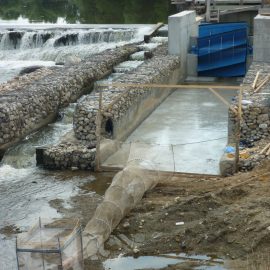The development of Europe’s remaining low-head hydropower potential is likely to play an important role in meeting Renewable Energy Obligations. However, current turbine technologies (e.g. Kaplan or Cross flow) often fail to meet the economic and/or ecological needs required by investors and regulatory bodies. Furthermore, physical risks to fish when passing through turbines, in addition to maintenance of river connectivity, present major ecological challenges.
Researchers at ICER have assessed a novel low-head hydropower device (the Hydrostatic Pressure Converter [HPC]) on fish passage and survival using a range of techniques. These included; numerical blade strike modelling and empirical validation, fish behavioural observations around the intake and tailrace of a prototype in a flume, and passage/survival of fish at a full-scale prototype in the field. Results highlight the importance of fish behaviour on the probability of injury/mortality during passage through hydropower devices and the need to eliminate “pinch-points” to reduce risk to downstream moving fish.
In acknowledgement of the need for viable (economically and environmentally) renewable energy technologies, this research was funded by the European Union’s 7th Framework Programme “Research priorities for the renewable energy sector”.
Media:
Publications:
Vowles, A.S., Karlsson, S.P., Uzunova, E.P. & Kemp, P.S. (2014). The importance of behaviour in predicting the impact of a novel small-scale hydropower device on the survival of downstream moving fish. Ecological Engineering 69: 151-159.
People:
Dr Andrew Vowles
Prof Paul Kemp
Dr Gerald Müller


